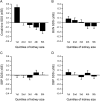Serum creatinine levels are significantly influenced by renal size in the normal pediatric population
- PMID: 20884775
- PMCID: PMC3022231
- DOI: 10.2215/CJN.00580110
Serum creatinine levels are significantly influenced by renal size in the normal pediatric population
Abstract
Background and objectives: Clinical and experimental data have shown that differences in nephron endowment result in differences in renal mass and predisposition to chronic renal failure, hypertension, and proteinuria. We hypothesized that a significant proportion of the variance in GFR, as estimated by serum creatinine, is attributable to differences in renal size in normal children.
Design, setting, participants, & measurements: A total of 1748 normal renal ultrasounds that were performed in children older than 6 months were reviewed. For each ultrasound, serum creatinine, serum blood urea nitrogen, and systolic and diastolic office BP were recorded. Renal size was evaluated as a function of renal length and thickness. All data were normalized for height, weight, age, and gender.
Results: When expressed as SD scores, a significant correlation was found between kidney size and serum creatinine (P < 0.0001) and between kidney size and serum blood urea nitrogen (P < 0.002). When dividing kidney size data per quintiles, a difference of 0.51 SD score in serum creatinine was observed between the lowest and highest quintile. No significant correlation was found with office BP measurements.
Conclusions: These data show that, even in the normal pediatric population, differences in renal function are significantly explained by differences in renal mass. Methodologic limitations of this study are likely to underestimate this relationship.
Figures


References
-
- Nyengaard J, Bendtsen T: Glomerular number and size in relation to age, kidney weight, and body surface in normal man. Anat Rec 232: 194–201, 1992 - PubMed
-
- Samuel T, Hoy WE, Douglas-Denton R, Hughson MD, Bertram JF: Determinants of glomerular volume in different cortical zones of the human kidney. J Am Soc Nephrol 16: 3102–3109, 2005 - PubMed
-
- Fulladosa X, Moreso F, Narvaez JA, Grinyò JM, Seròn D: Estimation of total glomerular number in stable renal transplants. J Am Soc Nephrol 14: 2662–2668, 2003 - PubMed
-
- Hoy WE, Douglas-Denton RN, Hughson MD, Cass A, Johnson K, Bertram JF: A stereological study of number and volume: Preliminary findings in a multiracial study of kidneys at autopsy. Kidney Int Suppl 83: S31–S37, 2003 - PubMed
MeSH terms
Substances
LinkOut - more resources
Full Text Sources

